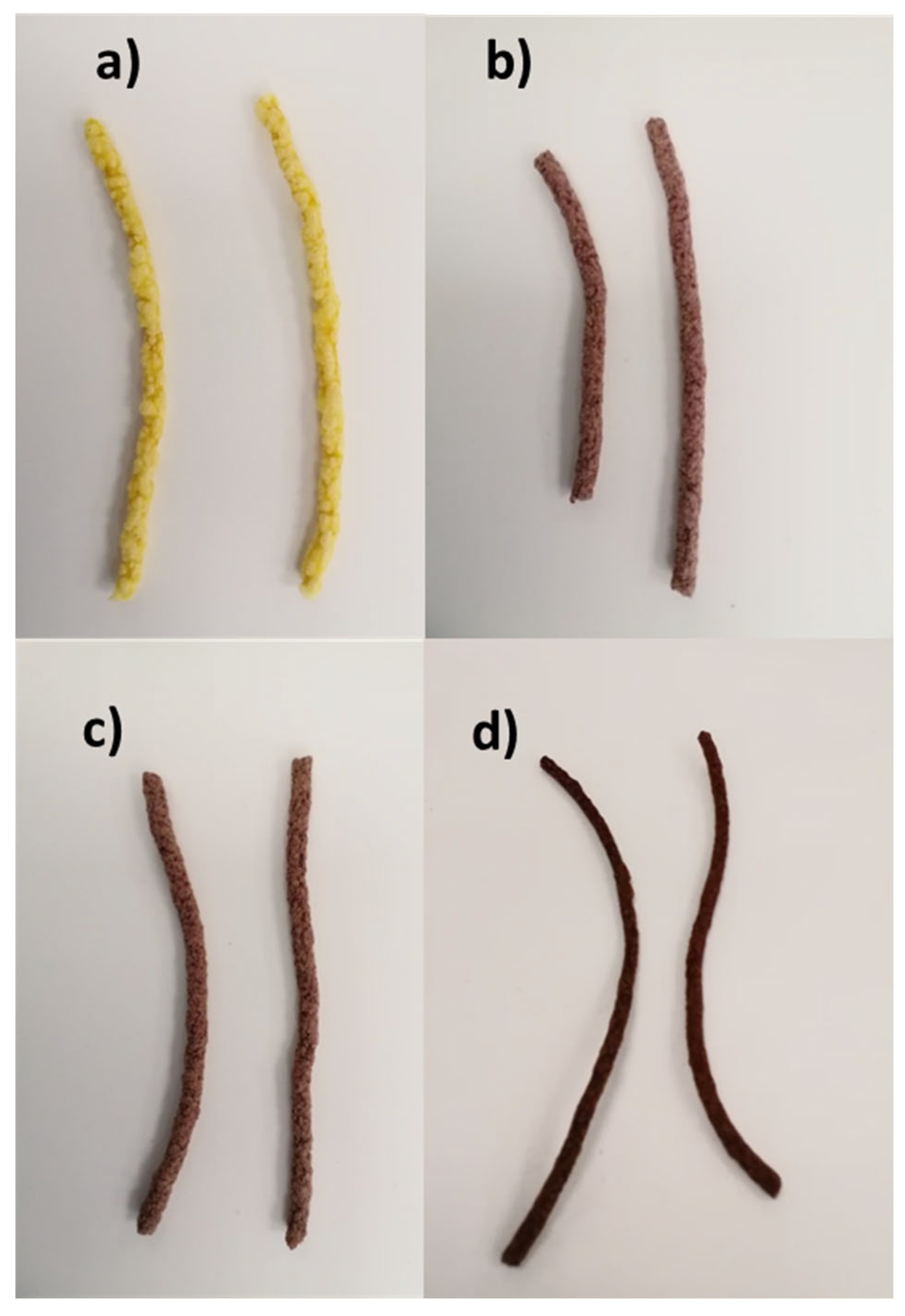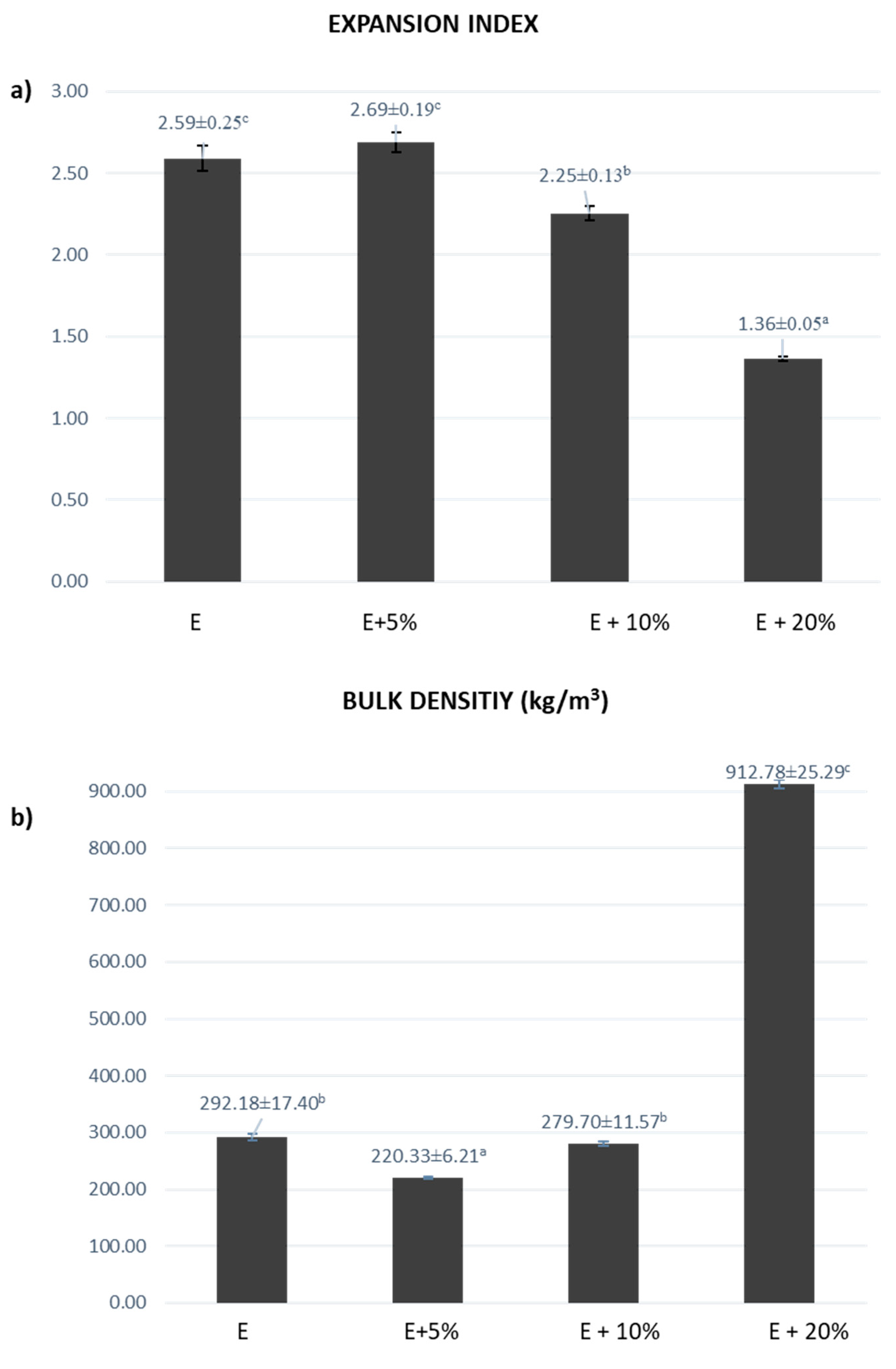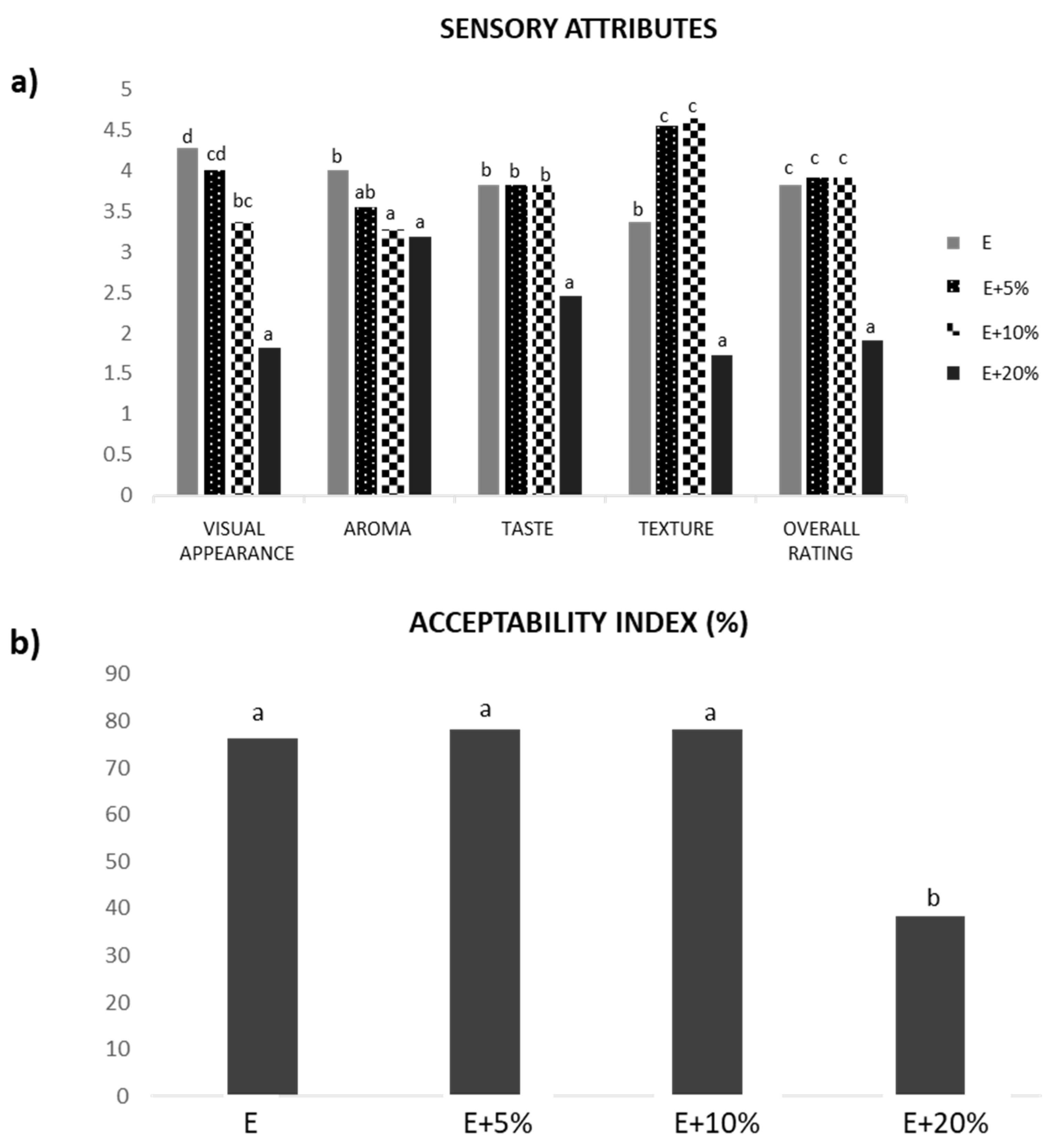Bioactive Compounds, Physical Parameters and Sensory Attributes of Purple Carrot-Enriched Maize Extrudates
Abstract
1. Introduction
2. Materials and Methods
2.1. Chemicals and Reagents
2.2. Materials
2.3. Moisture Measurements
2.4. Preparation of Samples for Extrusion
2.5. Extrusion-Cooking Procedure
2.6. Physical Parameters
2.6.1. Expansion Index
2.6.2. Bulk Density (BD)
- m: snack mass (g)d: snack diameter (mm)l: snack length (mm).
2.7. Sensory Attributes
2.8. Bioactive Compounds
2.8.1. Extraction of Polyphenols
2.8.2. Determination of TPC
2.8.3. Determination of TAC
2.8.4. Extraction of Carotenoids and Determination of TCC
- DF: dilution factorA1 cm1%: specific absorbance coefficient = 2500V: volume (mL)M: sample weight (g).
2.9. Determination of AA
2.10. Statistical Study
3. Results and Discussion
3.1. Moisture Content
3.2. Physical Properties
3.3. Sensorial Evaluation
3.4. Bioactive Compounds
3.5. Baking Effect on Maize Snacks Enriched with 5 and 10% PCP
4. Conclusions
Author Contributions
Funding
Institutional Review Board Statement
Informed Consent Statement
Data Availability Statement
Acknowledgments
Conflicts of Interest
References
- Revilla, P.; Alves, M.L.; Andelkovic, V.; Balconi, C.; Dinis, I.; Mendes-Moreira, P.; Redaelli, R.; de Galarreta, J.I.R.; Vaz Patto, M.C.; Zilic, S.; et al. Traditional foods from maize (Zea mays L.) in Europe. Front. Nutr. 2022, 8, 683399. [Google Scholar] [CrossRef]
- Repo-Carrasco-Valencia, R.; de la Cruz, A.A.; Alvarez, J.C.I.; Kallio, H. Chemical and functional characterization of Kañiwa (Chenopodium pallidicaule) grain, extrudate and bran. Plant Foods Hum. Nutr. 2009, 64, 94–101. [Google Scholar] [CrossRef]
- Bresciani, A.; Giordamo, D.; Vanara, F.; Blandino, M.; Marti, A. The effect of the amylose content and milling fractions on the physico-chemical features of co-extruded snacks from corn. Food Chem. 2021, 343, 128503. [Google Scholar] [CrossRef]
- Brennan, M.A.; Derbyshire, E.; Tiwari, B.K.; Brennan, C.S. Ready-to-eat snack products: Their role of extrusion technology in developing consumer acceptable and nutritious snacks. Int. J. Food Sci. Technol. 2013, 48, 893–902. [Google Scholar] [CrossRef]
- Kasprzak, K.; Oniszczuk, T.; Wojtowickz, A.; Waksmundzka-Hajnos, M.; Olech, M.; Nowak, R.; Polak, R.; Oniszczuk, A. Phenolic acid content and antioxidant properties of extruded corn snacks enriched with kale. J. Anal. Methods Chem. 2018, 2018, 7830546–7830553. [Google Scholar] [CrossRef] [PubMed]
- Gumul, D.; Berski, W.; Zieba, T. The influence of fruit pomaces on nutritional, pro-health value and quality of extruded gluten-free snacks. Appl. Sci. 2023, 13, 4818. [Google Scholar] [CrossRef]
- Gumul, D.; Ziobro, R.; Kruczek, M.; Rosicka-Kaczmarek, J. Fruit waste as a matrix of health-promoting compound in the production of corn snacks. Int. J. Food Sci. 2022, 2022, 7341118–7341129. [Google Scholar] [CrossRef]
- Culetu, A.; Susman, I.E.; Multescu, M.; Cucu, S.E.; Belc, N. Corn extrudates enriched with health-promoting ingredients: Physicochemical, nutritional, and functional characteristics. Processes 2023, 11, 1108. [Google Scholar] [CrossRef]
- Kozlowska, A.; Dzierzanowski, T. Targeting inflammation by anthocyanin as the novel therapeutic potential for chronic diseases: An update. Molecules 2021, 26, 4380. [Google Scholar] [CrossRef] [PubMed]
- Oancea, S. A review of the current knowledge of thermal stability of anthocyaninand approaches to their stabilization to heat. Antioxidants 2021, 10, 1337. [Google Scholar] [CrossRef] [PubMed]
- Ekici, L.; Ozturk, I.; Karaman, S.; Caliskan, O.; Tornuk, F.; Sagdic, O.; Yetim, H. Effects of black carrot concentrate on some physicochemical, textural, bioactive, aroma and sensory properties of sucuk, a traditional Turkish dry-fermented sausage. LWT Food Sci. Technol. 2015, 62, 718–726. [Google Scholar] [CrossRef]
- Pandey, P.; Grover, K.; Dhillon, T.S.; Chawla, N.; Kaur, A. Development and quality evaluation of polyphenols enriched black carrot (Daucus carota L.) powder incorporated bread. Heliyon 2024, 10, e25109–e25121. [Google Scholar] [CrossRef]
- Pandey, P.; Grover, K.; Dhillon, T.S.; Kaur, A.; Javed, M. Evaluation of polyphenols enriched dairy products developed by incorporating black carrot (Daucus carota L.) concentrate. Heliyon 2021, 7, e06880–e06899. [Google Scholar] [CrossRef]
- Nath, P.; Dukare, A.; Kumar, S.; Kale, S.; Kannaujia, P. Black carrot (Daucus carota subsp. sativus) anthocyanin-infused potato chips: Effect on bioactive composition, color attributes, cooking quality, and microbial stability. J. Food Process Preserv. 2022, 46, e16180–e16194. [Google Scholar] [CrossRef]
- Chhetri, L.; Rizwan, M.D.; Munkombwe, S.; Dorji, N.; Mutum, E. Utilization and characteristics of black carrot (Daucus carrot L.): Potential health benefits and effect of processing. Pharma Innov. J. 2022, 11, 30–41. [Google Scholar]
- Stoica, F.; Ratu, R.N.; Motrescu, I.; Cara, I.G.; Filip, M.; Topa, D.; Jitareamu, G. Application of pomace powder of black carrot as a natural food ingredient in yogurt. Foods 2024, 13, 1130. [Google Scholar] [CrossRef]
- Uzun, D.E.; Nemli, E.; Apak, R.; Bener, M.; Tomas, M.; Yagci, S.; Capanoglu, E. Starch-based composite formulation of chickpea flour and black carrot (Daucus carota L.) pomace in extruded snacks: In vitro gastrointestinal behavior and stability of bioactive compounds. Int. J. Biol. Macromol. 2025, 293, 139075–1399086. [Google Scholar] [CrossRef]
- Medina-Rendom, E.; Beltran-Medina, E.; Guatemala-Morales, G.; Padilla-Camberos, E.; Corona-González, R.; Mondragón-Cortez, P.; Arriola-Guevara, E. Optimization of extrusion conditions for an extruded food enriched with mango by-products (Mangifera indica var. Tommy Atkins) via responses surface methodology. Processes 2023, 11, 3182. [Google Scholar] [CrossRef]
- Singleton, V.L.; Rossi, J.A.; Menon, V.P. Colorimetry of total phenolics with phosphomolybdic-phosphotungstic acid reagents. Am. J. Enol. Vitic. 1965, 16, 144–158. [Google Scholar] [CrossRef]
- Giusti, M.; Wrolstad, R.E. Characterization and measurement of anthocyanins by UV visible spectroscopy. In Current Protocols in Food Analytical Chemistry; Giusti, M.M., Wrolstad, R.E., Eds.; Wiley: New York, NY, USA, 2001; pp. F1.2.1–F1.2.13. [Google Scholar]
- Smith, R.C.; Reeves, J.C.; Dage, R.C.; Schnettler, R.A. Antioxidant properties of 2-imidazolones and 2-imidazolthiones. Biochem. Pharmacol. 1987, 36, 1457–1460. [Google Scholar] [CrossRef]
- Benzie, I.F.F.; Strain, J.J. The ferric reducing ability of plasma (FRAP) as a measure of antioxidant power: The FRAP assay. Anal. Biochem. 1996, 239, 70–76. [Google Scholar] [CrossRef]
- Menis, M.E.C.; Milani, T.M.G.; Jordano, A.; Boscolo, M.; Silva, A.C.C. Extrusion of flavored corn grits: Structural characteristics, volatile compounds retention and sensory acceptability. LWT Food Sci. Technol. 2013, 54, 434–439. [Google Scholar] [CrossRef]
- Ackar, D.; Jozinovic, A.; Babic, J.; Milicevic, B.; Balentic, J.P.; Subaric, D. Resolving the problem of poor expansion in corn extrudates enriched with food industry by-products. Innov. Food Sci. Emerg. Technol. 2018, 47, 517–524. [Google Scholar] [CrossRef]
- Bisharat, G.I.; Oikonomopoulou, V.P.; Panagiotou, N.M.; Krokida, M.K.; Maroulis, Z.B. Effect of extrusion conditions on the structural properties of corn extrudates enriched with dehydrated vegetables. Food Res. Int. 2013, 53, 1–14. [Google Scholar] [CrossRef]
- Korkerd, S.; Wanlapa, W.; Puttanlek, C.; Uttapap, D.; Rungsardthong, V. Expansion and functional properties of extruded snacks enriched with nutrition sources from food processing by-products. J. Food Sci. Technol. 2016, 53, 561–570. [Google Scholar] [CrossRef] [PubMed]
- Tas, A.A.; Shah, A.U. The replacement of cerals by legumes in extruded snack foods: Science, technology and challenges. Trends Food Sci. Technol. 2021, 116, 701–711. [Google Scholar] [CrossRef]
- Gölge, E.; Ova, G.; Kemahlioglu, Ö.K.; Demirag, M.K. Effect of black carrot (Daucus carota L.) pomace in cake and cookie formulations as a functional ingredient on sensory analysis. Food Health 2022, 8, 103–110. [Google Scholar] [CrossRef]
- Sempio, R.; Sahin, A.W.; Walter, J.; Arendt, E.K.; Zannini, E. Impact of isolated and chemically modified dietary fiber on bakery products: Current knowledge and future directions. Cereal Chem. 2024, 101, 7–37. [Google Scholar] [CrossRef]
- Szymandera-Buszka, K.; Zielinska-Dawidziak, M.; Makowska, A.; Majcher, M.; Jedrusek-Golinska, A.; Kaczmarek, A.; Niedzielski, P. Quality assessment of corn snacks enriched with soybean ferritin among young healthy people and patient with Crohn’s disease: The effect of extrusion conditions. Int. J. Food Sci. Technol. 2021, 56, 6463–6473. [Google Scholar] [CrossRef]
- Blanch, G.P.; de Pascual-Teresa, M.L.; Ruiz del Castillo, M.L. Study of the phenolic composition and antioxidant properties of white-, yellow-, and black-corn (Zea mays L.) foodstuffs. J. Sci. Food Agric. 2023, 103, 6263–6271. [Google Scholar] [CrossRef]
- Saini, A.; Hamid Shams, R.; Dash, K.K.; Shaikh, A.M.; Kóvacs, B. Anthocyanin extract from black carrot: Health promoting properties and potential applications. J. Agric. Food Res. 2025, 19, 101533–101547. [Google Scholar]
- Saez-Escudero, L.; Blanch, G.P.; del Castillo, M.L.R. Influence of treatment with natural phytoregulators on purple carrots (Daucus carota L.) during cold storage. Appl. Sci. 2024, 14, 6359. [Google Scholar] [CrossRef]
- Saez-Escudero, L.; Blanch, G.P.; Morales, F.J.; Mesías, M.M.; Ruiz del Castillo, M.L. Health-related compounds and Maillard reaction products in dry and steam roasted purple carrots (Daucus carota L.). Food Chem. 2025, 483, 144296–144305. [Google Scholar] [CrossRef] [PubMed]
- Enaru, B.; Dretcanu, G.; Pop, T.D.; Stanila, A.; Diaconesa, Z. Anthocyanins: Factors affecting their stability and degradation. Antioxidant 2021, 10, 1967. [Google Scholar] [CrossRef]
- Menchaca-Armenta, M.; Ramírez-Wong, B.; Torres-Chávez, P.I.; Quintero-Ramos, A.; Ledesma-Osuma, A.I.; Frutos, M.J.; Gutiérrez-Dorado, R.; Campas-Baypoli, O.N. Effect of extrusion conditions on the anthocyanin content, functionality, and pasting properties of obtained nixtamalized blue corn flour (Zea mays L.) and process optimization. J. Food Sci. 2020, 85, 2143–2152. [Google Scholar] [CrossRef]
- Hu, Z.; Tang, X.; Zhang, M.; Hu, X.; Yu, C.; Zhu, Z.; Shao, Y. Effects of different extrusion temperatures on extrusion behavior, phenolic acids, antioxidant activity, anthocyanins and phytosterols of black rice. RSV Adv. 2018, 8, 7123–7132. [Google Scholar] [CrossRef]
- Ruiz-Gutiérrez, M.G.; Sánchez-Madrigal, M.A.; Quintero-Ramos, A. The extrusion cooking process for the development of functional foods. In Extrusion of Metals, Polymers and Food Products; Intech Open: London, UK, 2018; pp. 83–102. [Google Scholar]
- Turksoy, S.; Keskin, S.; Ozkaya, B.; Ozkaya, H. Effect of black carrot (Daucus carota L. ssp. sativus var. atrorubens Alef.) fiber addition on the composition and quality characteristics of cookies. J. Food Agric. Environ. 2011, 9, 57–60. [Google Scholar]
- Elder, R.S.; Mohr, G.S. The crunch effect: Food sound salience as a consumption monitoring cue. Food Qual. Prefer. 2016, 51, 39–46. [Google Scholar] [CrossRef]
- Baria, B.; Singh, A.K.; Panjagari, N.R.; Arora, S.; Minz, P.S. Colouring properties and stability of black carrot anthocyanins in yoghurt. J. Food Sci. Technol. 2021, 58, 3953–3962. [Google Scholar] [CrossRef]
- Wu, H.; Lu, P.; Liu, Z.; Sharifi-Rad, J.; Suleria, H.A.R. Impact of roasting on the phenolic and volatile compounds in coffee beans. Food Sci. Nutri. 2022, 10, 2408–2415. [Google Scholar] [CrossRef]
- Ha, S.Y.; Jung, J.Y.; Yang, J.K. Changes in phytochemical content, antioxidant activity, and anti-inflammatory properties of Cudrania tricuspidata fruits treated by roasting. Foods 2023, 12, 2146. [Google Scholar] [CrossRef] [PubMed]
- Badjona, A.; Bradshaw, R.; Millman, C.; Howarth, M.; Dubey, B. Faba bean processing: Thermal and non-thermal processing on chemical, antinutritional factors, and pharmacological properties. Molecules 2023, 28, 5431. [Google Scholar] [CrossRef] [PubMed]
- Akele, M.L.; Nega, Y.; Belay, N.; Kassaw, S.; Derso, S.; Adugna, E.; Desalew, A.; Arega, T.; Tegenu, H.; Mehari, B. Effect of roasting on the total polyphenol content and antioxidant activity of sesame (Sesamum indicum L.) seeds grown in Ethiopia. J. Agric. Food Agric. 2024, 16, 101163–101170. [Google Scholar] [CrossRef]





| Samples | TPC (mg GAE g−1 DW) | TAC (mg C3G 100−1 g DW) | TCC (µg EβC g−1 DW) |
|---|---|---|---|
| F | 1.66 ± 0.07 a * | n.d | n.d |
| E | 3.17 ± 0.51 ab | n.d | n.d |
| F + 5% | 3.87 ± 0.85 bc | 0.61 ± 0.12 a | 20.65 ± 2.26 a |
| E + 5% | 3.00 ± 0.07 bc | 0.49 ± 0.11 a | 14.44 ± 1.07 a |
| F + 10% | 4.04 ± 0.25 bc | 0.63 ± 0.09 a | 21.96 ± 1.55 a |
| E + 10% | 4.75 ± 0.60 bc | 0.50 ± 0.03 a | 22.32 ± 4.94 a |
| Samples | DPPH (µmol TE g−1 DW) | FRAP (µmol TE g−1 DW) |
|---|---|---|
| F | 5.02 ± 0.19 a | 0.64 ± 0.04 a |
| E | 3.94 ± 0.25 a | 0.50 ± 0.10 a |
| F + 5% | 10.65 ± 0.20 bc | 2.44 ± 0.58 b |
| E + 5% | 7.30 ± 0.71 b | 2.23± 0.08 b |
| F + 10% | 12.49 ± 0.25 bc | 2.41± 0.18 b |
| E + 10% | 6.61 ± 0.74 b | 2.72 ± 0.13 b |
| Correlation with DPPH | |||||
| TPC | TAC | TCC | |||
| r = 0.49 | p = 0.325 | r = 0.85 | p = 0.474 | r = 0.79 | p = 0.061 |
| Correlation with FRAP | |||||
| TPC | TAC | TCC | |||
| r = 0.77 | p = 0.013 | r = 0.96 | p = 0.002 | r = 0.98 | p < 0.001 |
| Samples | TPC (mg GAE g−1 DW) | TAC (mg C3G 100−1 g DW) | TCC (µg EβC g−1 DW) |
|---|---|---|---|
| E + 5% | 3.00 ± 0.07 bc | 0.49 ± 0.11 a | 14.44 ± 1.07 a |
| BE + 5% | 4.05 ± 0.30 bc | 0.39 ± 0.06 a | 13.96 ± 0.13 a |
| E + 10% | 4.75 ± 0.60 bc | 0.50 ± 0.03 a | 22.32 ± 4.94 a |
| BE + 10% | 5.22 ± 0.31 c | 0.41 ± 0.03a | 18.19 ± 1.05 a |
| Samples | DPPH (µmol TE g−1 DW) | FRAP (µmol TE g−1 DW) |
|---|---|---|
| E + 5% | 7.30 ± 0.71 a | 2.23 ± 0.08 a |
| BE + 5% | 6.11 ± 1.57 a | 2.18 ± 0.14 a |
| E + 10% | 6.61 ± 0.74 a | 2.72 ± 0.13 a |
| BE + 10% | 6.27 ± 1.45 a | 2.78 ± 0.07 a |
Disclaimer/Publisher’s Note: The statements, opinions and data contained in all publications are solely those of the individual author(s) and contributor(s) and not of MDPI and/or the editor(s). MDPI and/or the editor(s) disclaim responsibility for any injury to people or property resulting from any ideas, methods, instructions or products referred to in the content. |
© 2025 by the authors. Licensee MDPI, Basel, Switzerland. This article is an open access article distributed under the terms and conditions of the Creative Commons Attribution (CC BY) license (https://creativecommons.org/licenses/by/4.0/).
Share and Cite
Blanch, G.P.; Astocondor, L.F.; Ruiz del Castillo, M.L. Bioactive Compounds, Physical Parameters and Sensory Attributes of Purple Carrot-Enriched Maize Extrudates. Foods 2025, 14, 3218. https://doi.org/10.3390/foods14183218
Blanch GP, Astocondor LF, Ruiz del Castillo ML. Bioactive Compounds, Physical Parameters and Sensory Attributes of Purple Carrot-Enriched Maize Extrudates. Foods. 2025; 14(18):3218. https://doi.org/10.3390/foods14183218
Chicago/Turabian StyleBlanch, Gracia Patricia, Luz Fiorela Astocondor, and María Luisa Ruiz del Castillo. 2025. "Bioactive Compounds, Physical Parameters and Sensory Attributes of Purple Carrot-Enriched Maize Extrudates" Foods 14, no. 18: 3218. https://doi.org/10.3390/foods14183218
APA StyleBlanch, G. P., Astocondor, L. F., & Ruiz del Castillo, M. L. (2025). Bioactive Compounds, Physical Parameters and Sensory Attributes of Purple Carrot-Enriched Maize Extrudates. Foods, 14(18), 3218. https://doi.org/10.3390/foods14183218






